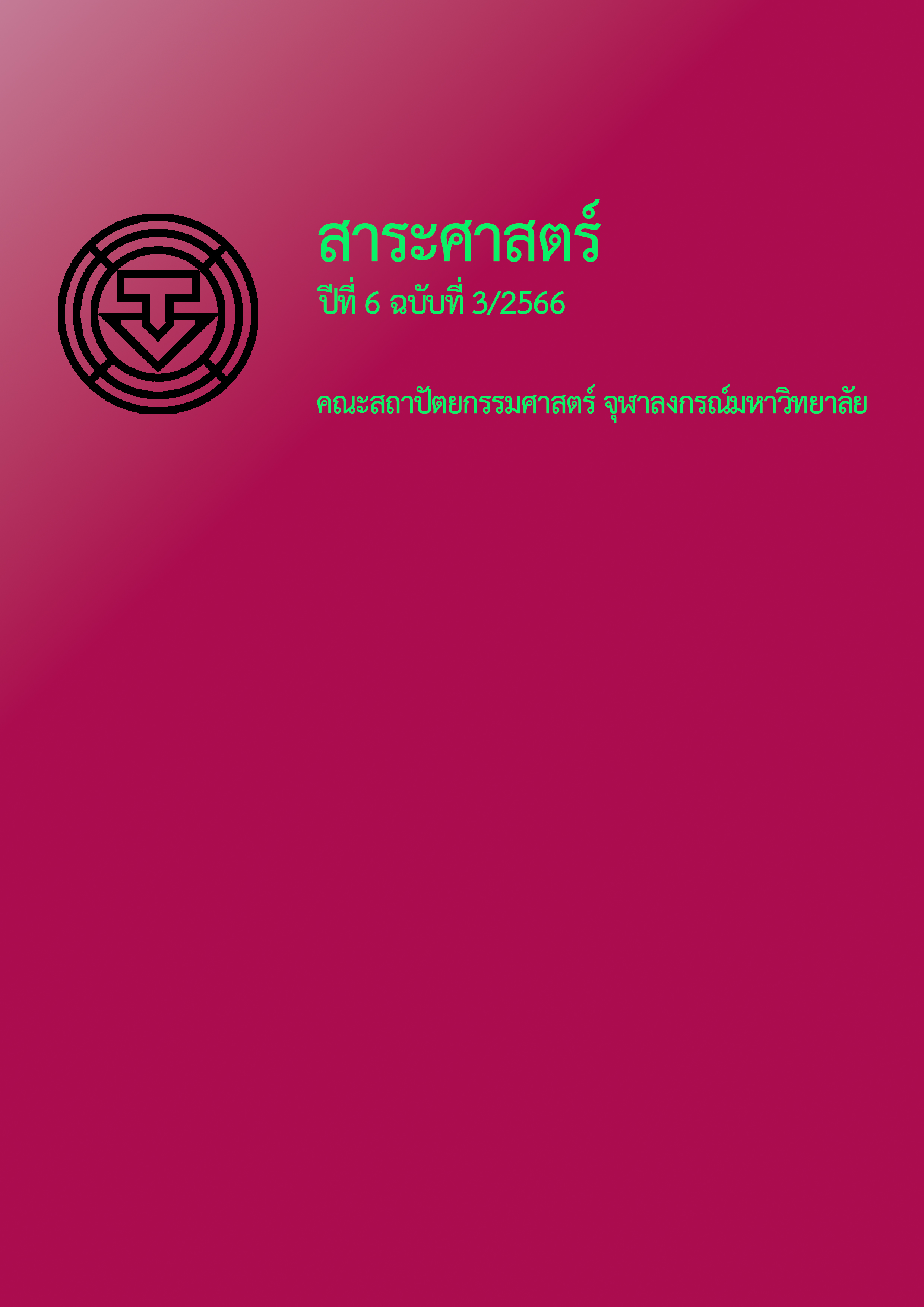ศูนย์พักพิงชั่วคราวสำหรับผู้ประสบภัยในสถานการณ์ภัยพิบัติ
Main Article Content
บทคัดย่อ
ภัยพิบัติทางธรรมชาติ เป็นเหตุการณ์ที่ส่งผลให้เกิดความเสียหายในชีวิตและทรัพย์สิน ซึ่งเกินกว่าความสามารถในการรับมือ โดยเฉพาะเดือนเมษายนและตุลาคมอาจเกิดพายุฝนฟ้าคะนองรุนแรงและพายุหมุนเขตร้อน รวมถึงภัยพิบัติครั้งใหญ่ที่คร่าชีวิตไปมากกว่า 220,000 คน ในเหตุสึนามิ พ.ศ. 2547 บทความวิจัยนี้จึงมีวัตถุประสงค์เพื่อศึกษาความสามารถในการรับมือภัยพิบัติ การจัดตั้ง การบริหารจัดการและความเป็นอยู่ในศูนย์พักพิงชั่วคราว งานวิจัยนี้จึงมีกรณีศึกษา 3 แห่งและเป็นการวิจัยเชิงคุณภาพโดยการสัมภาษณ์เชิงลึกผู้เชี่ยวชาญด้านการจัดตั้งและการบริหารศูนย์พักพิงชั่วคราว และบุคลากรทางการแพทย์ จำนวน 20 คน และผู้พักพิง จำนวน 10 คน พร้อมลงพื้นที่สังเกตแบบไม่มีส่วนร่วม
จากการศึกษาพบว่า ด้านการจัดตั้งศูนย์พักพิงชั่วคราวยังขาดการปรับปรุงสถานที่ให้เหมาะสมต่อการใช้งานของทุกคน และไม่สามารถรองรับการอพยพของผู้มีอาชีพเกษตรกรได้อย่างเหมาะสม รวมถึงผู้พักพิงยังต้องเผชิญกับความเครียดจากภัยพิบัติ และการอยู่ร่วมกันเป็นเวลานาน ในขณะที่ผู้ประสบภัยบางส่วนไม่ยอมอพยพไปศูนย์ที่ไกลจากชุมชน ด้านการบริหารจัดการศูนย์พักพิงชั่วคราวยังขาดการซักซ้อมระหว่างหน่วยงานท้องถิ่นและชุมชน เพื่อเรียนรู้ขั้นตอนการอพยพร่วมกัน ดังนั้นในการลดผลกระทบจากภัยพิบัติ ทุกภาคส่วนจำเป็นต้องเรียนรู้จากภัย และสร้างองค์ความรู้เพื่อหาทางรับมือภัยพิบัติและจัดตั้งศูนย์พักพิงชั่วคราวที่มีความเหมาะสม
งานวิจัยนี้แสดงให้เห็นสิ่งที่ผู้พักพิงต้องเผชิญ และเสนอแนะแนวทางการจัดศูนย์พักพิงชั่วคราว สำหรับผู้ประสบภัยที่ได้รับผลกระทบจากภัยพิบัติอย่างเหมาะสม
Article Details
เอกสารอ้างอิง
กระทรวงเทคโนโลยีสารสนเทศและการสื่อสาร. ศูนย์อุตุนิยมวิทยาภาคใต้ฝั่งตะวันออก. (ม.ป.ป.). ภัยธรรมชาติในประเทศไทย. ศูนย์อุตุนิยมวิทยาภาคใต้ฝั่งตะวันออก. http://www.songkhla.tmd.go.th/attachment/images/Disas.pdf
กระทรวงมหาดไทย. กรมป้องกันและบรรเทาสาธารณภัย. (2565). คู่มือการจัดตั้งและการบริหารจัดการศูนย์พักพิงชั่วคราว. http://assist.disaster.go.th/upload/minisite/file_attach/49/d1125511234053cc18e54514e01a978f.pdf
กองอำนวยการป้องกันและบรรเทาสาธารณภัยจังหวัดสงขลา. (2564). แผนเผชิญเหตุอุทกภัย และดินถล่มจังหวัดสงขลา ปี 2564. https://shorturl.asia/k0HQY
กองอำนวยการป้องกันและบรรเทาสาธารณภัยจังหวัดอุบลราชธานี. สำนักงานป้องกันและบรรเทาสาธารณภัยจังหวัดอุบลราชธานี. (2565). แผนเผชิญเหตุอุทกภัยจังหวัดอุบลราชธานี พ.ศ. 2565. https://shorturl.asia/VyQYC
คณะกรรมการป้องกันและบรรเทาสาธารณภัยแห่งชาติ. (2564). แผนการป้องกันและบรรเทาสาธารณภัยแห่งชาติ พ.ศ. 2564 - 2570. https://shorturl.asia/eQZwP
ไชยวุฒิ ตุดบัว. (2555). การประเมินการอยู่อาศัยของบ้านพักถาวรสำหรับผู้ประสบภัยน้ำท่วมภาคใต้ ปี พ.ศ. 2554 : กรณีศึกษาโครงการบ้านพักถาวรจังหวัดกระบี่ [วิทยานิพนธ์ปริญญามหาบัณฑิต ไม่ได้ตีพิมพ์]. จุฬาลงกรณ์มหาวิทยาลัย.
เทบพะวง ไชโกสี. (2561). แบบบ้านสำหรับผู้ประสบภัยพิบัติในสาธารณรัฐประชาธิปไตยประชาชนลาว [วิทยานิพนธ์ปริญญามหาบัณฑิต ไม่ได้ตีพิมพ์]. จุฬาลงกรณ์มหาวิทยาลัย.
ผู้จัดการออนไลน์. (2564, 8 กันยายน). ภัยพิบัติธรรมชาติ โหดจัด! คร่าชีวิตกว่า 2 ล้านคน “รุนแรงขึ้น 5 เท่า ในรอบครึ่งศตวรรษ.” ผู้จัดการออนไลน์. https://mgronline.com/greeninnovation/detail/9640000089072
ศูนย์ประสานงานโครงการวิจัยองค์กรปกครองส่วนท้องถิ่น และงานวิจัยเพื่อท้องถิ่น. (2562). โครงการวิจัย เรื่อง กลไกในการจัดการภัยพิบัติ กรณีน้ำท่วม โดยการมีส่วนร่วมขององค์กรปกครองส่วนท้องถิ่นและชุมชน. งาน.
สยามศักดิ์ จารุอาภรณ์ประทีป. (2545). แนวทางการออกแบบเพื่อปรับปรุงบ้านพักฉุกเฉินกรณีศึกษา โครงการบ้านต้นแบบ ต. น้ำก้อ จ.เพชรบูรณ์ [วิทยานิพนธ์ปริญญามหาบัณฑิต ไม่ได้ตีพิมพ์]. จุฬาลงกรณ์มหาวิทยาลัย.
สรวิศ วิฑูรทัศน์, Reyes, D. M. C., & Sarsycki, M. M. (2559). คู่มือการประเมินความเสี่ยงจากภัยพิบัติ. สำนักงานโครงการพัฒนาแห่งสหประชาชาติ สำนักงานประเทศไทย. https://www.disaster.go.th/upload/download/file_attach/58a6b30dd6232.pdf
สำนักงานข้าหลวงใหญ่ผู้ลี้ภัยสหประชาชาติ. กลุ่มประสานงานและจัดการที่อยู่อาศัยชั่วคราว. และองค์กรระหว่างประเทศเพื่อการโยกย้ายถิ่นฐาน. (2555).แนวทางการบริหารจัดการศูนย์พักพิงชั่วคราว. https://www.cccmcluster.org/sites/default/files/2018-10/Collective%20Centre%20Guidelines%20THAI.pdf
องค์กรพัฒนาและฟื้นฟูเมืองเมืองญี่ปุ่น. (ม.ป.ป.).URが施行する防災まちづくり 防災公園街区整備事業. chrome-extension://efaidnbmnnnibpcajpcglclefindmkaj/https://www.icic.jp/download/1130ur.pdf
อังคณา ช่วยค้ำชู. (2555, ตุลาคม-ธันวาคม). ประสบการณ์การจัดการศูนย์พักพิงช่วยเหลือผู้ประสบภัยน้ำท่วมมหาวิทยาลัยธรรมศาสตร์ ศูนย์ รังสิต. The Journal of Thailand Nursing and Midwifery Council, 27, 44-59.
Nastasi, B. K., & Schensul, S. L. (2005). Contributions of qualitative research to the validity of intervention research. Journal of School Psychology, 43(3), 177-278. https://doi.org/10.1016/j.jsp.2005.04.003


